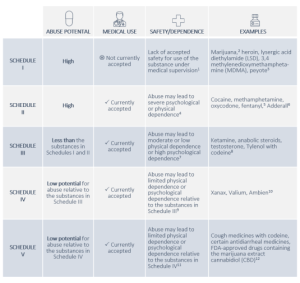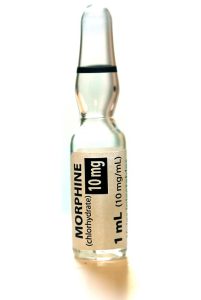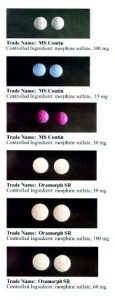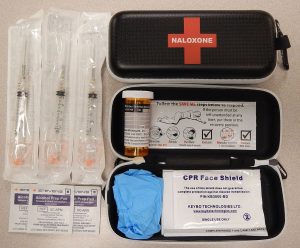11.4 Narcotic and Adjuvant Analgesics
Narcotics, also called opioids, are analgesics prescribed for moderate to severe pain. They work by binding to opiate receptor sites in the brain, and then block pain impulses coming to the brain from the nerves in the body. Narcotics also produce a level of sedation and a sense of well-being, also know as euphoria.

Narcotics are schedule medications (Schedule II to IV) because they have a high potential for abuse and addiction; therefore, they are highly controlled. The symbol C that is found on narcotic medications indicates that they are controlled substances (schedule medications), and the Roman numeral (II, III, or IV) indicates the assigned schedule based on how addicting the medication is. Fig. 11.7 shows the different schedule categories (I to V) for narcotics, other medications, and some illegal drugs.
A number of side effects are common to all narcotics because of the existence of different opiate receptors, which they also affect. These side effects include constipation, respiratory depression, sedation, euphoria, and antitussive effects. Often patients in a hospital who are prescribed narcotics are also given a laxative medication to prevent constipation. This is also done because these patients are already at an increased risk of constipation because of lack of mobility, surgical procedures, and other factors.
Much of the discussion on this page will focus on morphine sulphate, but there are a vast number of other narcotics that can be used to treat moderate to severe pain.
Some examples of narcotic medications include the following (WebMD, 2023):
- codeine
- fentanyl (Abstral, Actiq, Duragesic)
- hydrocodone (Zohydro ER)
- hydromorphone (Dilaudid)
- meperidine (Demerol)
- methadone (Dolophine, Methadose)
- morphine sulphate (Astramorph, Duramorph, MS Contin)
- oxycodone (OxyContin, Roxicodone)
- oxymorphone (Numorphan, Opana)
- tramadol (Ultram)
Key Concept
Methadone is also used in the treatment of drug addiction such as heroin (WebMD, 2022). It is often prescribed as part of a treatment program where patients will have to go and get the medication from a healthcare provider (WebMD, 2022). Methadone is used in addiction treatment as it does not provide a high like some other narcotics and prevents the symptoms of withdrawal and cravings. The term for this treatment if often referred to as replacement therapy (WebMD, 2022).
Morphine
Morphine (Astramorph, Duramorph, MS Contin) is an example of a narcotic used to treat moderate to severe pain. It binds to opioid receptors in the central nervous system (CNS) and alters the perception of and response to painful stimuli while also producing generalized CNS depression. Morphine is more accurately known as morphine sulfate, and this can be seen in the abbreviation MS found in the trade name MS Contin, as shown in Fig. 11.9 (Murphy et al., 2022). Morphine, similarly to codeine, is derived from the natural opium poppy (Murphy et al., 2022). Most other narcotics available, and listed above, are made synthetically.
Morphine (Fig. 11.8) is also commonly used to treat cancer pain and for pain at the end of life because there is no “ceiling effect,” meaning that the higher the dose, the higher the level of analgesia. Morphine is also commonly used in patient-controlled analgesia (PCA); other medications administered via PCA include hydromorphone and fentanyl. PCAs are common in the hospital setting and allow the patient to control the administration of their analgesic medications. The medications are connected to the patient’s intravenous line, and when the patient feels the need for more pain medication, they push a button that releases a specific dose of the drug but also has a lockout mechanism to prevent an overdose.


Combination Narcotic–Non-Narcotic Medications
Non-narcotic and narcotic medication are often given in combination because the non-narcotic medication provides a foundation of pain relief upon which the narcotic can build. As a result, less narcotic medication is needed to effectively control the pain (Li, 2019).
-
- Empirin-Codeine No. 3 (aspirin + codeine)
- Empirin-Codeine No. 4 (aspirin + codeine)
- Percodan (aspirin + oxycodone)
- Tylenol-Codeine No. 2 (acetaminophen + 15 mg of codeine)
- Tylenol-Codeine No. 3 (acetaminophen + 30 mg of codeine)
- Tylenol-Codeine No. 4 (acetaminophen + 60 mg of codeine)
- Percocet (oxycodone and acetaminophen)
Naloxone (Narcan)
Naloxone (Narcan) reverses pain relief and the CNS and respiratory depression caused by narcotics. It competes with opioid receptor sites in the brain and prevents the opioids from binding with the receptors or displaces opioids already occupying receptor sites. It is indicated for the complete or partial reversal of narcotic or opioid depression, which includes respiratory depression. Naloxone can be used in the case of an overdose and is widely available in most pharmacies and other locations across Canada. Fig. 11.10 provides an image of a common naloxone medication kit that can be obtained from pharmacies, clinics, and hospitals, and used to treat overdoses that occur outside the hospital setting.

Adjuvants
Adjuvant analgesics are medications that were developed for other purposes but were later found to be effective to treat pain. Examples of adjuvant medications include gabapentin (an anticonvulsant) and amitriptyline (a tricyclic antidepressant). Muscle relaxants are also considered to be adjuvant analgesics and are used for various musculoskeletal disorders such as multiple sclerosis (MS). Three different types of muscle relaxants will be discussed below: baclofen (Lioresal), cyclobenzaprine (Flexeril, Amrix), and tizanidine (Zanaflex). Although there are other types of adjuvants available, the ones discussed in this section are the more common types used in health care.
Baclofen
Baclofen (Lioresal) inhibits reflexes at the spinal level. It is used to treat muscle symptoms, such as spasm, pain, and stiffness, which are often caused by multiple sclerosis, spinal cord injuries, or other spinal cord disorders.
Cyclobenzaprine
Cyclobenzaprine (Flexeril, Amrix) reduces tonic muscle activity at the level of the brain stem. It is a muscle relaxant that is structurally similar to tricyclic antidepressants and is most often used to treat acute muscle spasms.
Tizanidine
Tizanidine (Zanaflex) acts as an agonist at central alpha-adrenergic receptor sites. It reduces spasticity by increasing the presynaptic inhibition of motor neurons. Tizanidine is used to treat increased muscle tone, spasms, and spasticity.
Bringing It All Together
A number of analgesic medications have been covered in this chapter, and as a means of summarizing this topic, watch the video below. It discusses the considerations, as suggested by the World Health Organization (WHO), for which analgesic medications are prescribed to patients. Note that the video discusses Paracetamol, which is another trade name for acetaminophen.
(Rhesus Medicine, 2020)
Table 11.2. Common Narcotic Medications
| Generic Name | Trade Name | Reason for Administering |
| morphine sulphate | Astramorph, Duramorph, MS Contin | Moderate to severe pain |
| codeine | – | Moderate to severe pain |
| fentanyl | Abstral, Actiq, Duragesic | Moderate to severe pain |
| hydrocodone | Zohydro ER | Moderate to severe pain |
| hydromorphone | Dilaudid | Moderate to severe pain |
| meperidine | Demerol | Moderate to severe pain |
| methadone | Dolophine, Methadose | Moderate to severe pain |
| oxycodone | OxyContin, Roxicodone | Moderate to severe pain |
| oxymorphone | Numorphan, Opana | Moderate to severe pain |
| tramadol | Ultram | Moderate to severe pain |
| aspirin + codeine | Empirin-Codeine No. 3, Empirin-Codeine No. 4 | Moderate to severe pain |
| aspirin + oxycodone | Percodan | Moderate to severe pain |
| oxycodone + acetaminophen | Percocet | Moderate to severe pain |
| acetaminophen + codeine | Tylenol-Codeine, Tylenol-Codeine No. 3, Tylenol-Codeine No. 4 | Moderate to severe pain |
| nalaxone | Narcan | Narcotic (opioid) overdose |
| baclofen | Lioresal | Multiple sclerosis, muscle spasms, moderate to severe pain (adjuvant) |
| cyclobenzaprine | Flexeril, Amrix | Muscle spasm, moderate to severe pain (adjuvant) |
| tizanidine | Zanaflex | Muscle spasms, moderate to severe pain (adjuvant) |
(WebMD, 2023)
Attribution
Unless otherwise indicated, material on this page has been adapted from the following resource:
Ernstmeyer, K., & Christman, E. (Eds.). (2020). Nursing pharmacology. Chippewa Valley Technical College. https://wtcs.pressbooks.pub/pharmacology/, licensed under CC BY 4.0
References
Murphy, P. B., Bechmann, S., & Barrett, M. J. (2022, June 20). Morphine. https://www.ncbi.nlm.nih.gov/books/NBK526115/
Rhesus Medicine. (2020, September 14). WHO analgesic ladder – Pain management | World Health Organisation analgesic ladder (+ side effects) [Video]. YouTube. https://www.youtube.com/watch?v=x-ntxFpTK3g
WebMD. (2023). Drugs & medications A–Z. https://www.webmd.com/drugs/2/index
WebMD. (2022). Methadone. https://www.webmd.com/mental-health/addiction/what-is-methadone
Image Credits (images are listed in order of appearance)
CRS Controlled Substance Act Schedules by Joanna R. Lampe, Public domain
Morphine 1mL Vial by DanielTahar, CC BY-SA 4.0
Morphine DOJ by U.S. Department of Justice, Public domain
analgesic medications that are available with a prescription, are highly regulated, and are used to treat moderate to severe pain
medication used to treat a cough
medications with a primary use other than pain relief that have analgesic properties in some painful conditions
a state of continuous activity
increase in muscle tone or stiffness

